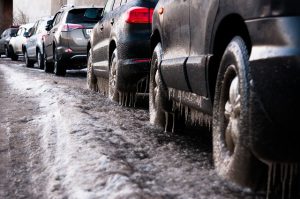 Living in the Northern Hemisphere often means frigid winters, snow, sleet, and ice, which is not ideal for motor vehicles. There’s the misery of waking up to a car covered in ice and snow and the grit, grime, and debris that finds its way both inside and outside of the car. The bigger problem, however, is the salt used on roads, which is highly corrosive to cars. Keeping a clean car during winter helps protect your vehicle’s interior and exterior.
Living in the Northern Hemisphere often means frigid winters, snow, sleet, and ice, which is not ideal for motor vehicles. There’s the misery of waking up to a car covered in ice and snow and the grit, grime, and debris that finds its way both inside and outside of the car. The bigger problem, however, is the salt used on roads, which is highly corrosive to cars. Keeping a clean car during winter helps protect your vehicle’s interior and exterior.
Prepare BEFORE Winter
The best time to start winterizing your car is during fall. Start waxing your car before winter strikes. Wax is a good way to protect the paintwork, as it helps water, ice, and snow slide off easily. A good way to check if your car is waxed well enough is to see if water “beads up” when washing the car. The best option in paint protection is a good-quality paint sealant. There are some excellent sealants out there that will protect your car for four to six months.
Wash Your Car Frequently
Nobody is jumping up and down for joy at the thought of braving the freezing cold outside to wash their car. But did you know that washing your car is more important during winter than any other time of the year? That’s because of what we mentioned earlier — salt. Salt is bad news for the metal of cars, as it leads to rust that not only looks ugly but will also lower the value of your car. Driving on salted roads means you will get some of it sticking to your car. This is the reason keeping your car clean during winter, especially the undercarriage which picks up most of the salt, will help protect it.
Use Rubber Car Mats
This is one of the simplest tips to implement. All that snow and slush on your boots ends up in your car. It melts, leaving puddles of water that soak into material car mats and also seep down to the floor of the car. Again, this is a surefire way to end up with corroded floors. A rubber mat catches the water better and dries a lot faster than a material mat.
Parking Inside or Outside — Which Is Best?
This is debatable. You may think that parking inside is best. After all, parking in a garage keeps your car cleaner for longer, and there’s no hassle of scraping off ice and snow every time you head out. On the flip side, many experts say that when all that salty snow and ice melts, it creates the ideal environment for salt to eat at your car. Parking it outside keeps the ice and snow frozen, which actually slows down the corrosion. The alternative is to buy a good-quality car cover, which means you can park it outside and help protect it from the elements.
Of course, if you really want to avoid car hassles during winter, don’t drive it. But as this is a car and not a bear, it’s highly unlikely your car will hibernate during winter. So just take some steps to keep it clean and protected, and you’ll drive your way through winter with ease.
Image via Pixabay





